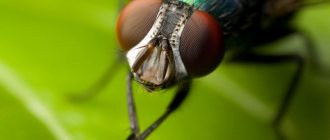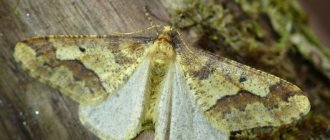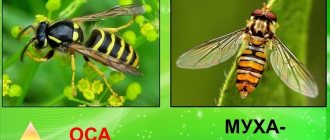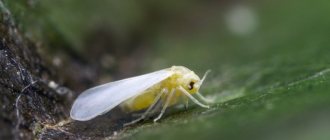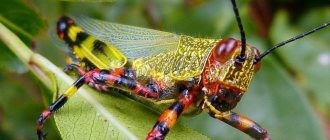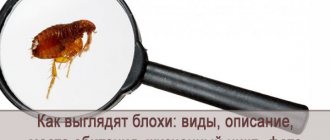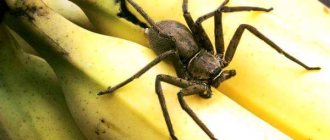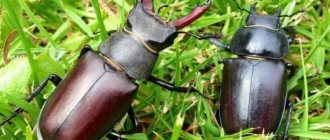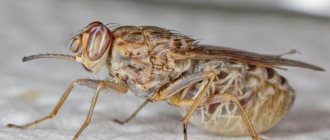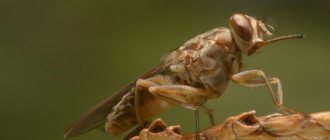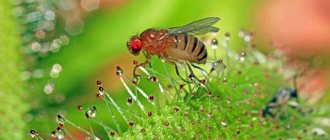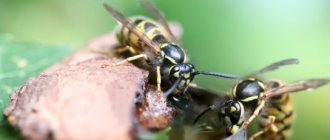Biologists know about six thousand species of syrphids. Most of them live in North America and Eurasia (with the exception of Central Asia). And two species are found even in the subarctic zone. In Africa, South America and Australia, these insects are almost absent.
Fly like a wasp
Hoverflies (lat. Syrphidae) are often found in vegetable gardens and summer cottages, where they actively pollinate flowers on garden and fruit crops.
On a note!
They are called hoverflies due to the sounds they make when flying, similar to the murmur of running water.
They are widespread and are found on all continents at positive air temperatures. According to biological classification, scientists place them in the order of short-whiskers and the family of Diptera.
Syrphids use a remarkable ability for mimicry, having an appearance very similar to the stinging insects of bees and wasps, having the same yellow and black striped abdomen, as seen in the photo of the hoverfly, thanks to which they escape from the attacks of birds and predators. Hoverflies are virtuosos in the “flight” business: their ability to hover or loiter in one place, and then break off and quickly fly away, is their distinctive feature. It is due to the unique structure of the wings: one pair is normal, and the second has been reduced over time into club-shaped halteres, which helps the insect maintain balance and control stopping in flight.
Male wasp flies have their own territory, which they vigilantly guard, periodically hovering in space. Even mating with females occurs in flight.
Externally, hoverflies resemble bees or wasps: they have an elongated body with a yellow belly and black stripes, some species have a black body with yellow spots.
On a note!
Due to the similarity of hoverflies to stinging insects, many are interested in the question of whether they bite. The answer may be information about the absence of not only a sting, but also poisonous glands. Therefore, they are absolutely harmless to humans.
Hoverfly
Description, distribution
The body length of the syrphid reaches on average 10-12 mm (in larger species - up to 25 mm). The legs are short, light, one pair of wings. The proboscis is not too long, the body is covered with barely noticeable fluff. The eyes are large, dark brown, the head is semicircular, slightly flattened. The color resembles that of wasps, bees or bumblebees: a dark abdomen with bright yellow oblong spots that look like stripes (there is one such stripe on each segment of the abdomen).
Hoverfly larvae are elongated, reminiscent of leeches, but slightly wrinkled. Their body is slightly narrowed at the front. In general, the larvae are slow, but their mobility increases sharply during the hunt (they make a very sharp lunge at the prey). Their color is greenish and transparent, which allows you to see the translucent internal organs. This stage lasts a month.
The pupae look like a drop of resin.
The eggs are white or with a pinkish (sometimes greenish or yellowish) tint, translucent, very small, develop in 2-4 days.
You can meet hover flies in Eurasia and North America (but not in its northernmost part). The main habitat of the syrphid is forest clearings, vegetable gardens, and fields, where it feeds on flower nectar or pollen.
Benefits and harms
The benefits or harms of hoverflies cannot be judged unambiguously. Much depends on the specific species living near gardening farms or agricultural fields. By feeding on insect pests such as aphids, the larvae of these flies preserve fruit trees and shrubs. And in mountainous areas where the number of bees is reduced, adult hoverflies are irreplaceable helpers for humans. By pollinating flowering cultivated plants, they increase their productivity.
But at the same time, some species are malicious pests of lily crops. By eating onions, garlic and damaging the bulbs of tulips, daffodils, hyacinth, the larvae create big problems for gardeners and flower growers. Damaged plants slow down and wither. And bulbs intended for storage quickly rot.
The rat flea is a carrier of such a serious disease as plague. You don’t know how to effectively get rid of scale insects on indoor plants? Then this article is especially for you.
Decontamination is a comprehensive measure aimed at cleaning a room or area from ticks. What means are used in this case, read the article at the link.
Varieties
Insects are usually divided into 4 types. The hoverfly larva is shown in the photograph, but depending on whether it belongs to a particular group, it looks different.
Entomophages
These are useful predators. They feed on aphids, mites, leaf flea beetles, as well as the larvae of these pests. So we can consider them helpers, especially since they contribute to better pollination of flowers.
The most striking representatives of this type are the larvae of the common hoverfly. One individual eats up to two hundred pests per day! The flower hoverfly is a gardener's assistant in the struggle for the harvest. Although it is called common, this hoverfly is beautiful in appearance.
There is also a beeweed; it is larger in size than the wasp syrphid. Even larger is the bumblebee flower fly.
On a note! Silky hoverflies eat aphids.
Types of hoverflies
Such striped flies have many varieties: in the world - up to 60 thousand, in Russia their number is 800. All types of hoverflies are distinguished by the different arrangement of yellowish and black stripes, as well as the diet of their larvae: some of them are herbivores, others are predators, still others eat tree bark.
The most common of them:
- The common hoverfly or flower fly with yellow stripes, reaches 12 mm in length, is a good pollinator, the larvae of which destroy garden pests;
- Onion hoverfly (Delia antique) – its size is about 1 cm, the larvae feed on the juice and pulp of bulbous plants;
- Wasp fly (Temnostoma vespiform) - a fly similar to a wasp in coloring and body shape, size up to 18 mm, its larvae consume rotten wood;
- The tenacious bee fly (Eristalis tenax) is a fly similar to a bee, 15 mm long, darker in color;
- Aquatic hoverfly or eristalis fly (Eristalis) - lives near standing ponds, swamps or puddles with musty water, has a special proboscis for breathing in order to consume air from the surface;
- Tufted hoverfly wasp (fasciolatum).
The undeniable benefits of the hoverfly
Most syrphid fly larvae feed on aphids, thrips, grasshoppers and other soft-bodied predators such as small caterpillars. They move along the surface of plants, raise their heads to feel for prey, grab and suck it dry, and then shed their exoskeleton.
The larva of the Whirling Fly eats the aphids on the plant.
Each larva can consume up to 400 aphids during development. When syrphid larvae are abundant, they can reduce aphid populations by 70-100%.
How to get rid of hoverflies?
To preserve the harvest, you should get rid of the pest in a timely manner. Gardeners recommend using:
- chemicals;
- folk ways.
The control method is selected depending on the number of pests.
Chemicals
If larvae are noticed in the garden bed, they must be promptly disposed of. You can find a huge amount of products in stores. The most popular are:
- "Tiofos";
- "Heptahtor";
- "Fly-eater";
- "Inta-Vir";
- "Tabazol".
Important: when choosing this or that product, you need to study the instructions, otherwise you can destroy not only the larvae, but also the crop.
Folk remedies
If there are not yet many larvae in the garden or flowers, you can use traditional methods:
- Water the garden bed with ammonia solution. 5 tablespoons of the substance are added to 10 liters of water.
- Sprinkle the beds with wood ash. You can also use tobacco powder.
- After harvesting, treat the soil with copper sulfate.
- Remove damaged plants and then burn them.
- The hoverfly does not like the smell of carrots, so it needs to be sown next to the onion bed.
- Treat the soil with urea. Add 1 tablespoon of the substance to a ten-liter bucket. One liter of solution is enough per square meter of land.
Important: folk methods have proven themselves over several decades.
Wasps
The insects themselves feed on flower nectar and fruit juice, but their queen and larvae need protein food, so adult individuals have to hunt a lot. Perhaps the wasp is the most dangerous winged predator on our list today. Some of the species, for example, the Larra burrowing wasp, are capable of destroying even a mole cricket, and those that live in our area calmly cope with flies, beetles, bedbugs, and, of course, mosquitoes, leaf rollers and aphids.
Wasp larvae
Some types of wasps, such as typhus, paralyze the victim with their venom and then lay an egg in its body. The effect of the poison lasts for several hours, then the larva continues to move, and a new insect develops inside it, feeding on it. In order to carry out this procedure with Khrushchev, wasps can dig holes in the ground to a depth of 10 cm.
Nutrition and life cycle
Life cycle of the syrphid fly Like bees and bumblebees, syrphid flies are pollinators and feed on nectar and pollen collected from plants and flowers.
The sugar consumed from such food gives them the necessary energy, and pollen is needed in the form of protein for egg maturation and reproduction. They give preference to umbelliferous and asteraceous plants; they fly in meadows, visiting dandelions and other flowers, also among fruit bushes and trees. The first appearance of adult flies occurs at the end of spring; mating usually occurs only in July, but the active summer will continue until the first half of August.
Adult female flies, similar to bees, when laying eggs, look for places where there will be rich food for future offspring, for example, a cluster of aphids or small spider mites. Hoverfly larvae appear after 3-4 days, their length is usually about 1 cm, and they look like maggots. They hardly move, but actively eat aphids; their daily diet is up to 200 individuals, due to which they gradually grow.
Interesting!
During its development, each larva is capable of absorbing up to 2 thousand small insect pests, making it a predator that benefits garden plants. However, some types of flies also have plant tastes. The onion hoverfly, for example, eats onion greens, which is why it is classified as a pest.
Gradually, the grown larva forms into a puparium - a shell similar to a drop of resin, inside which the insect matures. The adult flies out of the cocoon, after 12-14 days, after 1-2 hours it spreads its wings and is able to fly.
On a note!
One female hoverfly lays about 200 white eggs per season, attaching them to grass or plant stems, or less often directly into the soil. Then generations change.
How to attract a hovering fly to your site
Because adult hover flies feed on pollen and nectar, planting flowering plants in your area or between crops will attract them and increase the likelihood that they will lay their eggs on infested plants.
We recommend planting plants such as: alisum, aster, coreopsis, daisies, dill, fennel, lavender, marigolds, mint, statice, sunflower, wild mustard and zinnia.
Try to keep plants rich in nectar and pollen always blooming in your area from spring to autumn.
The use of insecticides and other chemicals, especially broad-spectrum ones, should be avoided whenever possible.
Stages of development
Female syrphids prefer to lay eggs in close proximity to aphid colonies. Predators that emerge from eggs do not have legs, so proximity to an aphid colony plays a vital role for them. They catch aphids carried by the wind in flight. The larva simply swings the upper part of its body and grabs the desired food from the air.
The hoverfly stays in the larval stage for no longer than three weeks. During this time, each of them manages to eat up to two thousand pests. Fully mature larvae build drop-shaped cocoons in which they pupate.
The process lasts two weeks, after which a flying insect is born. It breaks through the shell of the cocoon and begins to live in a new form.
During the season, there are two to four generations of hover flies. It depends not so much on the weather as on the type of flies. The number of larvae depends on the abundance of food in the area.
Lacewings
Lacewings, sometimes mistakenly called lacewings for their delicate yellow-green wings, are not important in themselves in protecting the garden from insects, but their larvae are the real heroes of this war for the harvest. Each larva destroys up to one and a half hundred aphids, scale insects, small mites, etc. per day. Moreover, over the summer, 2 generations of lacewings hatch, each of which actively seeks food for 3 weeks.
Lacewing larvae are quite cunning - they hide from ants that pose a danger to them, disguising themselves as aphids.
Lacewing larva
What are the features of reproduction?
An adult female is capable of laying 150-200 eggs. The eggs are small in size and white in color. The number of clutches directly depends on external conditions. The fly lays eggs in the stems of plants, as well as on the buds of trees. Within a week, the larvae hatch. In appearance they resemble maggots. Throughout the month, the representative will actively eat for full development.
Over time, pupation occurs. Adult flies begin to fly in July-September. The larvae go to winter at the first cold snap.
Hoverfly larvae pose a danger to spider mites and small insects. A fly can also eat hundreds of aphids.
You will learn more about hoverflies in this video:
Description
The hovering fly gets its many names from the fact that adults hover over flowers, like a hummingbird or hawk moth. The larvae can be voracious predators of small insects, especially aphids, and all aphid-eating species belong to the subfamily Syrphinae.
Flies are common on many crops affected by aphids and other small, soft-bodied insects.
Are larvae harmful?
The larvae of harmful hoverflies destroy the entire available crop. The insect prefers:
- garlic;
- daffodils;
- tulips;
Fly larvae often destroy flowers, such as tulips
- onion;
- hyacinths;
- gladioli.
After contact with a harmful larva, the plant stops growing and developing. Withering gradually occurs. The leaves are drying up.
Harm from a murmuring fly
The daffodil fly, or the murmuring fly, causes great damage to the bulbs of daffodils, tulips, hyacinths, gladioli, and the rhizomes of irises.
Before winter, larvae that have not gone through three stages of development are buried in the ground near bulbous plants and overwinter in the bulbs. They eat away the inside of the bulb, and if the plant does not die, then in the spring it grows extremely slowly and does not bloom.
The pest does not like peat, so one of the methods of plant protection is to mulch the planting with peat.
Infected plants can be watered with a solution of pine flour powder, and it is recommended to heat-treat the planting material during the washing and drying process.
Fly - description and characteristics
The body length of a fly can be from a few millimeters to 2 cm. The insect has a pair of membranous wings, a rather large head, endowed with an oral organ - a proboscis, designed for sucking up liquid food. The fly's body consists of three parts: head, abdomen and chest, ending with three pairs of legs. Each leg of a fly is divided into five segments. One part is the foot, with two sharp claws and sticky pads. This feature allows the fly to quickly move along the ceiling and any vertical surfaces.
The eyes of a fly are a unique organ. Thanks to several thousand hexagonal facets, the fly has a circular field of vision, so its huge eyes can easily simultaneously see everything that happens to the side and even behind. The organ of smell is the antennae, which can recognize odors at great distances.
Behavior
Dangerous and harmless insects have different patterns of behavior, by which they can be easily distinguished by an observant person. These features of syrphids are even noted in the names of flies in different languages:
- Russian – hoverfly: for a specific sound in flight;
- English, German, Dutch - soaring flies: for the ability to hover in the air;
- Swedish, Finnish – flower flies: for feeding on plants;
- Czech – mottleds/sedges: for color;
- Slovak – trembling: for hanging in the air.
Interesting!
The scientific name comes from the Greek “syrphos”, that is, “animal, mosquito”.
What are the main characteristics
The place of insect development directly depends on the species. Some live in anthills and eat young individuals. The body of a representative can be slender or, on the contrary, massive. On average, adult individuals reach a length of 5-25mm. There are no hard hairs on the body that are characteristic of other flies. Small fluff is visible. The color is dark with yellow elongated spots.
The color resembles bees, bumblebees or wasps. The difference is that the hoverfly has only one pair of wings. The peculiar color is needed for protection from birds, which are afraid to attack the insect, suspecting the presence of a sting and poison.
Thanks to the specific structure of the wings, the insect is able to hang in the air in one place for a long time, and also abruptly change direction. Adult insects appear at the end of June. It is at this time that the fly emerges from the pupa.
Years are carried out until the beginning of August. After this, the insect lays eggs, which are small and white in color.
The main characteristics depending on the stage of development are presented in the table.
| Caterpillars | The length of the caterpillar does not exceed 1 cm. The body color is white. Nutrition directly depends on the subspecies of the representative. |
| Doll | The pupa has the shape of a drop. In appearance it resembles amber. During wintering the color turns brown. In summer, the shell takes on a yellow tint. |
| Imago | Adult representatives have an elongated body. The color is dark, often black. |
The new generation hatches from eggs in August-September.
The pupa then hatches into a full-fledged fly.
What does it look like
If you catch a glimpse of a hoverfly fly, you may get the impression that it is a wasp or a bee. This is very useful for such insects, since birds, seeing such a coloring, do not consider them as prey, but fly past. The body of wasp flies can be both slender and large.
The average size of an adult is 4-25 mm. A distinctive feature of these insects is the absence of hard hairs covering the body, which are found in flies of other families.
Syrphidologists study these flies with great interest. They are amazed by the virtuosity of the hoverflies during flight. Syrphids are capable of flying for a long time and at the same time they carry out all movements very quickly. But if such a need arises, then they freely hang in one place.
Male wasp flies actively defend their territory . They hang in one place for a long time, driving away other applicants. Rivals, seeing that this territory is occupied, fly in search of other places. After hovering, insects are able to abruptly change their flight direction. It is interesting that even the mating process for many of them occurs during flight.
Features of color
The body of wasp flies is covered with fine fluff, similar to that of bumblebees. The color is dark with yellow or reddish elongated stripes covering the back and abdomen.
The peculiarity of the color is that flies can be easily confused with bees, wasps or bumblebees. They can be distinguished only by the absence of a second pair of wings.
What do Diptera eat?
Not every dipteran insect eats everything. What do flies eat? Adults of these insects differ in their feeding types.
We have already found out that gadflies are aphagous, and their larvae are obligate parasites.
In addition, flies can feed according to the following types:
- Nectarophages - they choose plant juices and sometimes animal droppings for food. A typical representative is the Wohlfart fly, a carrier of intestinal diseases and helminths.
- Obligate coprophages - both larvae and adults feed on the excrement of mammals, incl. and man. These are mainly grazing insects.
- Facultative coprophages - they eat excrement, but also willingly feast on the remains of human food. There are predators among them. A typical representative is the familiar brownie.
- Obligate hematophages - they bite painfully and suck the blood of animals and humans. Like, for example, the autumn zhigalka.
- Facultative hematophages - the adults of these insects happily feast on the secretions of sweat glands and mucous membranes, as well as blood protruding from wounds. But they do not damage the “victim’s” skin. Additionally, they can feed on plant juices and feces. A typical representative of this group is the market fly.
- Facultative necrophages. The very name of the group suggests that its typical representative is the corpse fly. The carrion fly feasts on dead mammals, but does not disdain excrement, food waste, and plant juices. The green fly is also a facultative necrophage.
- Polyphages - these are the insects that eat anything. A typical representative of polyphages is the housefly.
Whatever insects eat, their “menu” is varied and, moving from one food item to another, they carry a lot of pathogenic microorganisms on their paws and in their intestines. Therefore, the fight against these dipterous pests is one of the key links in the prevention of human intestinal diseases.
ladybugs
Even a child knows these cute, bright beetles. And here is something that would be useful for summer residents to know about them: ladybugs and their larvae are more active than many in destroying aphids, scale insects, and copperheads on the site. An adult insect eats several dozen aphids a day, and its larvae eat ten times more.
Ladybug larva
Thanks to this, ladybugs are literally necessary in every area, especially in gardens and flower beds, where aphids become a real scourge, destroying the leaves of apple trees, pears, roses and other plants.
Ladybugs wake up in the spring, actively feed and reproduce throughout the warm period, and with the onset of cold weather they look for shelter. To attract these insects to your site, you need to provide them with houses. For this purpose, both decorative industrial shelters and hollow stems tied in bunches, sprinkled with peat or sawdust, laid in secluded corners of the garden can be used.
- How to attract living helpers to the garden?
Don’t know how to fill your area with life and attract beneficial insects and birds? To do this, just follow a few tips.
Types of flies, names and photographs
There are 3,650 species of flies in the world, some of which are particularly common:
- house fly
a gray insect native to the Asian steppes. Distributed everywhere, most often near human habitation. Externally, many species are similar to the house fly, but it is distinguished by a special break at the edge of the wings. Under favorable conditions, the insect can live up to 2 months;
Housefly
- hoverfly (syrphid)
in appearance and habits it is similar to a wasp. The insect is distinguished by a black and yellow striped body and transparent wings. The hoverfly feeds on the nectar of flowering plants and is absolutely harmless. The fly got its name from the murmuring sound made by its wings when hovering;
Hoverfly
- green (carrion) fly
An insect with a shiny emerald body that lives near sewage and carrion. To avoid being eaten after mating, the male fly first offers the female some food;
Carrion fly
- common milkweed (tenacious) or bee-shaped milkweed
considered a subspecies of hover flies. A large insect, up to 1.5 cm long, with a dark-colored body covered with hairy pubescence. Beeworm larvae that enter the human body can cause serious intestinal disorders;
Ilnitsa vulgare
- ktyr
a large predatory fly that poses a danger to mosquitoes, midges, bees, and also similar flies. Killing various dangerous insects with a sharp sting and poison, tyri flies bring significant benefits to humanity;
Fly ktyr
- Tsetse fly
inhabitant of the African continent. The main source of nutrition for this dangerous predator is the blood of wild mammals, as well as livestock and people. Tsetse flies are carriers of trypanosomes, which cause an incurable disease that destroys the immune and nervous systems and leads to death.
Tsetse fly. Alan R Walker, CC BY-SA 3.0
Biology of hoverflies
Hoverflies, due to the peculiarities of their evolution and similarity with wasps, have spread over most of the globe. They are found everywhere except hot deserts, tundras and, of course, Antarctica. Entomologists count about 6 thousand species of these insects, of which more than 1.5 thousand are found in the Palearctic, 800 in Russia, and 2 species were found even in the subarctic zone.
How to distinguish syrphid from stinging insects
Although the bee fly is similar to wasps and bees, it is absolutely harmless. Below are the signs by which the hoverfly can be distinguished from dangerous insects:
- Syrphid flies are dipterous insects, so the presence of only one pair of wings is the first difference from bees, which have four wings.
- The fly's wings are larger and wider.
- The ability to “hover” in the air and suddenly change direction of flight. This happens thanks to the halteres - a reduced pair of wings.
- A fly has thinner limbs than a bee, and plant pollen does not accumulate on them.
- There are no hard hairs on the body of the hoverfly, but there is fine fluff, like a bumblebee.
- Wasps are non-social insects. Individual individuals live on their own and group only during the mating period.
Reproduction and development
At the end of June, after wintering, an adult wasp fly emerges from the pupa. After mating, females lay eggs and continue to fly until the end of July. Insect eggs develop in the soil near lily and umbrella plants or on the branches of bushes and trees.
A few days later, leech-like larvae up to 1 cm long emerge from the eggs. They have a greenish, pale yellow or pinkish tint. The larvae feed and grow for about a month, after which they pupate. At the end of July - beginning of September, adult flies emerge and lay eggs again. The second generation develops to the pupal stage and goes to winter.
Nutrition
The diet of adult hoverflies, like bees, consists of flower nectar and pollen. Therefore, insects can be found near the flowers of fruit trees, berry bushes and in the garden near umbrella plants.
The larvae, depending on the species, differ in the way they feed. Among them there are vegetarians, predators and saprophages that eat decaying remains. Adherents of plant foods gnaw the stems and bulbs of lilies. Aquatic types of flies dive to the bottom of reservoirs and eat the dendrite. Some exotic representatives of hoverflies will not refuse to feast on dung and decaying wood, while others live in symbiosis with ants, feeding on their reserves.
Predatory larvae are the worst enemies of spider mites, aphids and other small insects, eating not only adults, but also their eggs. It is interesting to watch the larvae hunt for aphids. The leech-like larva crawls along the stems, and when it finds an aphid, it stops and raises the front part of its body (like a snake), swings and attacks its prey. Then the larva sucks out the contents of the aphid's body, leaving only the chitinous shell. In a day, a voracious fly larva can eat several hundred aphids.
Struggle
If you notice hoverfly larvae in your bulbous plantings, you need to take immediate action. In this case, proceed as follows, using both means of destruction and preventive measures:
- Severely damaged plants are removed from the site and burned.
- The rest of the plantation is treated with conventional insecticides: Aktara, Decis, and so on.
- The planting sites for daylilies are changed annually, alternating them with other crops.
- Carrots are added to lily plants, the smell of which repels onion flies and hoverflies.
- Bulb crops are also saved by early planting, so that by the time the pests fly out they are already strong enough.
- Preventive treatment with odorous substances is used: tobacco dust, mothballs, ash, hot pepper and the like.
- Mulching and loosening the soil prevents its compaction, which is a barrier for pests.
After harvesting bulbous crops, if there is a suspicion of hoverfly infestation, it is advisable to treat the soil with a solution of copper sulfate.
We are surrounded by a diverse world of insects: from small spider bugs that are not even visible to large bright butterflies that delight the eye. And among this wide variety of creatures there are flies - small winged insects, completely ugly to look at. They are not favored because of their annoyingness and intrusiveness, but worst of all, they are carriers of various microorganisms and bacteria that can cause various diseases: from simple poisoning to tuberculosis and typhus. We are surrounded by a large number of species of flies, which we need to be able to recognize so as not to be confused with other insects that are harmless to humans.
Why is mimicry needed?
The traditional answer is to scare away predators. But among insectivorous birds there are many who feed on stinging insects. The color will not scare off such predators, but will attract them. Other birds, as observations by ornithologists and entomologists have shown, perfectly distinguish syrphids from wasps, bumblebees and bees by behavior and flight pattern.
But mimicry is not useless. Bumblebees use it to penetrate bumblebee nests. For other syrphids, their external similarity to dangerous insect species saves their lives during the flight of their chicks. When a bird approaches a flower, the flies quickly detach and fly away. Insects that have protection are confident in their safety and are in no hurry to fly away. The chick tries to catch prey, gets a sting in its tongue and no longer goes near insects of similar appearance.
Later, the bird will learn to distinguish flies from their dangerous prototypes, but during the mass emergence of chicks, mimicry saves the lives of many syrphids.
Literature
- Violovich Ya. A.
Syrphids of Siberia (Diptera, Syrphidae). Determinant. - Novosibirsk: Science, 1983. - P. 149 - Gusev V. I., Ermolenko V. M., Svishchuk V. V., Shmigovsky K. A.
Atlas of mosquitoes of Ukraine. - K.: State Educational and Pedagogical Institute "Radyanska School", 1962. - P. 149 (Ukrainian) - Red Book of the Republic of Adygea: Rare and endangered objects of flora and fauna: Part 2: Animals. — Second edition / Department of Environmental Protection, Natural Resources and Emergency Situations of the Republic of Armenia; resp. ed. A. S. Zamotailov; scientific ed. parts 2: A. S. Zamotailov, V. I. Shchurov, M. I. Shapovalov, R. A. Mnatsekanov. — Maykop: Quality, 2012. — P. 356 ISBN 978-5-9703-0347-4
- Speight MCD
Species accounts of European Syrphidae (Diptera) // Syrph the Net: the database of European Syrphidae. Volume 65, Glasgow, 2011. - P. 239-240 (English)
| Flora and fauna of the Rtishchevsky district | ||
| Flora of Rtishchevsky district | ||
| Mushrooms of the Rtishchevsky district | Fauna of Rtishchevsky district | Invertebrates Vertebrates |
| Paleofauna | ||
| Rtishchevo and Rtishchevsky district in topics | ||
| Symbols and awards | ||
| People of the city and region | ||
| Administrative-territorial division | History of the Rtishchevsky region | |
| Economy | ||
| Education and science | ||
How to deal with onion hoverfly
The onion hoverfly is the most dangerous pest. The insect destroys both vegetables and plants. Damaged bushes rot and die completely.
To fight, you can use the drug Decis
To combat onion hoverfly, it is recommended:
- remove damaged plants and burn them;
- treat the beds with preparations - Decis, Agita;
- change the location of planting bulbous plants annually;
- treat the beds with ammonia;
- loosen the soil.
You should get rid of the pest as early as possible, before the number reaches a critical level.
Interesting Facts
Here are some fun facts about hoverflies:
- Imitating bees helps flies escape insectivorous birds. The chicks hatch when the wasps fly out. Then their parents teach them to be wary of striped insects. Hoverflies fly out when the chicks grow up and do not risk attacking suspicious flies.
- Hoverflies get their name from the characteristic sound of their wings, similar to the murmur of water.
- Male wasps hover in the air for a long time, protecting their territory and females during the mating season.
Natural enemies of the hoverfly
Hover flies generally have no serious enemies other than spiders and birds. However, no species can survive without an enemy somewhere in the food chain. Species of sand wasps specialize in catching hover flies, and common wasps will also catch hover flies in the summer when their numbers are high. Wasps can attack the larvae of the murmuring fly and kill up to half of the young individuals.
The spider caught and eats a floating fly on a leaf.
Lifestyle
Males fly at altitudes of 3 meters and above. In flight, hoverflies accurately imitate wasps of the genus Vespula
; when landing, the insects hold their black front legs as if they were antennae, reminiscent of the black antennae of Vespula
, and vibrates them, as a wasp does with its antennae.
Adult insects of both sexes are often found on flowers; for these purposes they visit pastures and meadows; often sit on the leaves of shrubs, etc. Prefers flowers of the following taxa: butane ( Chaerophyllum
), clematis ( Clematis
), dogwood (
Cornus
), hawthorn (
Crataegus
), hogweed (
Heracleum
), honeysuckle (
Lonicera xylosteum
), poppy (
Papaver nudicaule
), buttercup (
Ranunculus
), raspberry (
Rubus idaeus
), elderberry (
Sambucus
), groundsel (
Senecio
), mountain ash (
Sorbus
).
Summer time
Flights occur between June and July.
Reproduction
Larva.
The larvae are xylophages and develop in rotting wood of deciduous trees (maple, alder, birch, beech, aspen, oak, willow and linden). Larval development takes 2 years.
Larvae
If syrphid imagoes are vegetarians, then the larvae have a very wide food supply. Among the syrphid larvae there are:
- predators that feed on aphids, small caterpillars and other insects without chitinous cover;
- detritivores: habitat: water bodies, food supply - rotting organic matter;
- phytophages that feed on living herbaceous plants;
- xylobionts that live under the bark of trees and feed on rotting wood or tree sap;
- inquilines, living in the nests of social insects and finding food there;
- coprophages that develop in animal manure.
Beware, Diptera
It should also be noted that in addition to representatives of wild nature, there are flies that are strongly associated with human settlements ecologically. These are synanthropic flies and they pose the greatest epidemiological danger, being carriers of many diseases.
First of all, this includes the following families of Diptera:
- real flies;
- blue or green meat;
- gray meat;
- cheese;
- Drosophila fruit flies;
- blood-sucking flies.
Representatives of gadflies of three families are also epidemiologically dangerous:
- subcutaneous gadfly;
- gastric;
- cavitary.
An adult gadfly is classified as an aphagam, i.e.
its mouth is reduced, it does not feed, but lives off the reserves that it accumulated as a larva. But it is dangerous for humans for another reason. Since the lifespan of this insect is short, the gadfly tries to lay larvae as quickly as possible. The subcutaneous gadfly lays larvae under the skin of an animal or person, causing myiasis. Larvae parasitizing in the animal's stomach, which got there with contaminated food, cause catarrh.
But the most unpleasant thing is the cavitary gadfly. The flying female injects her larvae into the eyes and nostrils of the animals. Can affect people. Once in the host's body, the larvae parasitize in the nasal passages, maxillary and frontal sinuses, pharynx, eyelids and even inside the eyeball.
Danger to humans
Larvae of the genus Eristalis are not parasites. But beekeeper eggs laid on food can be swallowed by humans. When swimming in a dirty pond, there is a possibility that larvae may enter the body. An alternative option for infection is the female laying eggs near the anus. Being in the rectum, it irritates the walls of the organ with its breathing tube. The resulting myiasis is called eristalosis. The disease has been registered in India, Australia, South America and some European countries - Denmark, Belgium, Spain.
Symptoms of the disease: diarrhea, vomiting, abdominal pain, itching in the anus. In some cases, symptoms do not appear. The disease is treated with medication, metronidazole and nifuroxazide are prescribed.
How to deal with harmful insects?
Control methods include changing planting sites. It is possible to replant crops that serve as food for the larvae in the same place only after three years. However, if the pest in the area goes on a rampage and starts eating beets and carrots, the use of insecticides cannot be avoided.
The hoverfly is a two-winged insect that looks like a bee or wasp, but differs from them in having fewer wings. Where such an insect lives, its differences from predators, nutrition and reproduction - all information and interesting facts that will be of interest to nature lovers and gardeners.
What are the common types
There are many types of insects. Not all representatives are harmful and potentially dangerous to the garden. Do not rush to destroy the hoverfly without understanding what species it is.
The main subspecies include:
- tufted hoverfly;
- beekeeper;
- wasp fly and onion fly;
- flower hoverfly.
There are several types of hoverflies.
The larva is inactive, but voracious. Pests can destroy the entire crop and reduce all the efforts of the gardener to nothing. Onion hoverflies are pests. It is 1 cm in length. It is the larvae that harm plants.
Aquatic hoverflies feed on stale water. Found in puddles and swamps. There is a trunk that resembles a breathing tube.
The common hoverfly is a floral species. The length reaches 12 mm. Pollinates plants and destroys aphids. The wasp resembles a wasp, as the name suggests. The only pronounced difference is the absence of a sting. It feeds on rotten wood.
Opinion of an experienced gardener
Ivan Skoroboynikov from the Moscow region
“I had to fight the onion hoverfly. I found out that it was this particular fly by contacting an agronomist I knew who worked on a nearby farm. He also told me how to deal with this pest. But I started taking effective measures too late that year and lost half of the harvest. The next year, when planting onions, I applied the granulated preparation “Bazudin”. This year, not a single pest was noticed in the garden.”
What folk remedies are there?
Folk remedies are safer than chemicals. Do not harm plants. Experienced gardeners recommend:
- treat the soil with copper sulfate;
- destroy excessively damaged plants by burning;
- sprinkle the beds with tobacco powder or wood ash;
- plant carrots near onions and garlic, as well as bulbous flowers, since the fly cannot tolerate the aroma of the vegetable.
It is better if the gardener uses several methods simultaneously.
